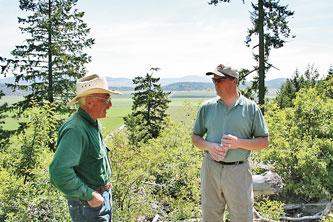|
Water Pressure
 |
 |
H&N photo by
Ty Beaver
Jim Creswell of Long Lake Ranch, left, speaks with
Larry Holzgang, business development officer with
Oregon Economic and Community Development Department,
on a ridge above Long Lake valley. |
|
| |
June 14, 2007 Herald and News by Ty
Beaver
Imagine an area a fraction of the acreage, but 20 times deeper
than Upper Klamath Lake that would hold as much water as the
lake for environmental and irrigation needs.
That is the vision Klamath County
commissioners and other water storage advocates shared with
state officials Wednesday on a tour of the Long Lake valley
southwest of Upper Klamath Lake.
Commissioners said they wanted to demonstrate to state
officials the benefits of the project as a way to garner
support.
“This is truly a water bank,” said
Commissioner Al Switzer.
More storage needed
Klamath County leaders say the area needs more storage to
augment the Basin’s water supply, and Long Lake has been
considered a possible site for decades.
Wednesday’s tour provided an opportunity to demonstrate what
would need to be done to convert the valley into a reservoir.
A lake with an average depth of 160 feet could be accomplished
with minimal improvements. The construction of a saddle dike
along a low point on the valley’s northeastern ridge would
raise the depth to 200 feet, storing water equivalent to the
amount in Upper Klamath Lake.
The reservoir would be filled during times of peak flow in the
early spring. U.S. Bureau of Reclamation and Pacific Power
officials indicated there is about three to four months most
years when water that is not needed for electricity generation
or fish is sent downriver because there is no storage capacity
available.
During a particularly wet spring several years ago, Switzer
said enough excess water was sent through the river system to
provide for the Basin’s annual irrigation needs.
 |
|
| |
Creating a reservoir for the
excess water would allow it to be banked for drier periods of
the year and even for longer droughts.
“It’s not new water, it’s just water
we’re not able to catch right now,” said Pablo Arroyave,
director of the Klamath Basin Reclamation office.
Idea started in 1960s
The concept of transforming the valley into water storage
started in the 1960s with Jim Kerns, a Klamath County
businessman, said Commissioner John Elliott. Kerns suggested
that the valley, along with Aspen and Round lakes, be studied
for potential as reservoirs.
Commissioners and groups concerned
with local water supplies have stepped up efforts to develop a
water storage site. Mandated flows for endangered fish in the
Klamath River and climatic changes have diminished snow packs,
but increased rainfall require the county to have a better way
to manage water gained in excess years.
The Long Lake valley is higher in elevation than Upper Klamath
Lake, which would require it to be filled by pumps from the
Geary Canal. The pumps would require power, but that could be
offset when the water is sent back to Upper Klamath Lake as
needed, creating a downhill flow that could be applied to
electrical turbines.
Challenges
Challenges to the project exist.
Reclamation officials estimate
the cost at $500 million, though commissioners say they’ve
heard estimates half as much. The money would be used
primarily to build a saddle dike, move earth and secure rights
from the area’s several landowners.
Greg Addington, executive director of the Klamath Water Users
Association, said he was concerned with how long it would take
to complete the project given its reliance on action from the
federal government. Officials from the Oregon water resources
department said the new storage site would require a water
rights permit and other regulatory measures.
Commissioners also brought up
necessary mitigation for the project’s environmental impact,
as it would submerge acres of timber and grazing land, part of
which is managed by the BLM.
Despite the challenges, the commissioners said they were ready
to push through a project already 40 years in the making.
State officials in attendance also voiced their interest and
support, as did those who would lose their homes in the
process.
The home of Jim Creswell, owner of the Long Lake Ranch at the
southern end of the valley, would be covered with more than
150 feet of water if the project goes through, but he said so
long as he’s compensated, he’ll find a new home.
“The project is so logical and should work so well,” he said.
“I don’t want to stand in front of that.”
��” Ty Beaver |

